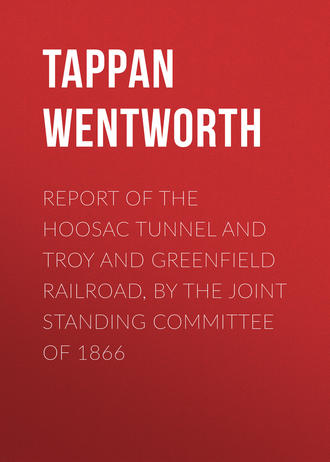 полная версия
полная версияReport of the Hoosac Tunnel and Troy and Greenfield Railroad, by the Joint Standing Committee of 1866

Tappan Wentworth
Report of the Hoosac Tunnel and Troy and Greenfield Railroad, by the Joint Standing Committee of 1866
Hon. Joseph A. Pond, President of the Senate.
Sir:—I herewith transmit to the legislature the Report of the Joint Standing Committee of 1866 on the Hoosac Tunnel and Troy and Greenfield Railroad.
I am very respectfullyYour obedient servant, TAPPAN WENTWORTH, Chairman .REPORT
The Joint Standing Committee of 1866 on the Hoosac Tunnel and the Troy and Greenfield Railroad, authorized to visit the tunnel and railroad, examine into the condition and progress of the work, and to report fully the result of such examination respectfully
REPORT:That since the adjournment of the legislature the Committee in a body visited the tunnel and railroad in June, and again in October, and they continued their examination of the condition and progress of the work by sub-committees in the months of July, August, September, November and December; (one of the examinations being exclusively devoted to the operations on the railroad which were commenced late in October;) the others to the tunnel and the various structures and mechanical operations connected therewith, including an examination of the existing contracts, and an inquiry into the general organization adopted to carry out the laws and purposes of the State in regard to the enterprise.
The Committee have also examined the records and the doings of the directors of the Troy and Greenfield Railroad from the organization of the corporation until the surrender of the railroad to the State, and have made extracts from the records to show the financial condition of the corporation, its dealings with the contractors for constructing the road and tunnel, and also the embarrassed condition of the contractors and corporation from 1855 to 1861, which finally led to the practical abandonment of the contract on the part of Messrs. H. Haupt & Company, and the surrender of the road to the State under the mortgages which had been given to secure the loan advanced by the Commonwealth in aid of the road and tunnel. These extracts from the records, with extracts from some of the laws passed upon the subject of the railroad and tunnel, together with remarks of the Committee upon the legislation of the State, the doings of the directors, and their efforts and those of the contractors to prosecute the enterprise being too long for the body of this Report, will be found in the Appendix at A. And a synopsis of the action and condition of the corporation at the time of, and previous to the surrender of the road, and the relation of the contractors to the corporation and to the State, will be stated before entering upon the particular description of the condition and progress of the work the present year, as observed by the Committee.
The charter of the Troy and Greenfield Railroad was granted in 1848, authorizing the construction of a railroad from a "point on the Vermont and Massachusetts Railroad, at or near Greenfield," to the line of the States of New York or Vermont, to connect with any railroad that might be constructed from or near the city of Troy in New York. Its capital stock was limited to $3,500,000. Authority was given in the charter to contract with any contiguous railroad leading from either of the above-named States, for the use of the same or any part thereof, or for operating the two roads conjointly, or for hiring such other railroad, or for letting their own railroad to the owners of any other road which should compose a part of the railroad line between Troy and Boston, of which the Troy and Greenfield Railroad should be a part.
The corporation was organized June 1, 1848. April 11, 1849, the directors voted an assessment of three per cent. upon its capital stock, and this assessment was the only one that was substantially collected, and on the first day of October, in the same year, they voted to put the construction of the road under contract as soon as sufficient subscription should be obtained therefore, commencing at Pownal, Vermont, and Greenfield. In January, 1850, $2,203.94 had been received into the treasury, and $2,203.57 had been expended with the approbation of the president of the corporation, leaving in the treasurer's hand $0.37.
Sundry assessments was voted from time to, time, the last vote being in May, 1852, amounting in all to 75 per cent. upon the subscriptions, but they were rescinded in July, 1858, and a new series of assessments were afterwards made which the Committee understand were as unproductive of beneficial results as were the former, upon which only partial payments had been made by a portion of the subscribers.
A contract for constructing the road was made with Messrs. Gilman and Carpenter in October, 1850. At the close of the year 1850, stock to the amount of $250,800 had been subscribed, of which $72,000 was payable in land damages, and $50,000 was taken by the contractors.
At this period in the history of the corporation, with $138,800 of available cash subscription, of which three per cent. had been paid, the corporation applied to the State for aid by a loan to enable it to prosecute the enterprise it had assumed, and this application was continued without success until 1854, when the legislature passed the Act authorizing a loan of $2,000,000, upon conditions which are particularly set forth in the Loan Act, (see Appendix A and B,) which, modified by subsequent legislation, discloses the policy of the State in granting its assistance to the undertaking.
It is proper to state, that at the time this loan was granted, there was no prospect of opening this line of travel by individual efforts, and the amount of the loan, taking into consideration the then assumed estimates of its probable cost, shows that the State assumed to defray the cost of an enterprise to the completion of which available individual means had proved inadequate.
In 1855, a contract for the construction of the road and tunnel was made with E. W. Serrell. The capital stock of the corporation was fixed at $1,500,000. This contract was changed two or three times, and finally ended in one executed by H. Haupt and Henry Cartwright. For an account of these changes, and of the votes and transactions of the directors and the contractors, reference is made to Appendix A, where the same will be found in detail.
Upon a careful examination of these votes and transactions, the Committee come to the conclusion that the financial embarrassments of the corporation from the year 1855, when the first contract with E. W. Serrell was made to the time of the suspension of the works under the last contract with H. Haupt & Co., are apparent. And it is also apparent that during the same time, the contractors assumed, to a very great extent, the control and responsibility of the enterprise.
Under the first contract, and on the day of its acceptance, the direction of the engineering operations within the tunnel was left with the contractor; excepting measuring for estimates and the final acceptance of the work; and on his subscribing $600,000 to the capital stock, $800,000 (less the new subscriptions,) was added to the contract prices for the work.
Under the second contract with Serrell, Haupt & Co., the directors voted to substitute bonds for stock in payment of the work until 2,000 feet of the tunnel was completed, and to pay the discounts and losses to which the contractors might be required to submit, not exceeding fifteen per cent. per annum; and also, to issue to the contractors bonds to the amount of $100,000 in addition to payments. Said bonds were to be sold or pledged by Haupt & Co., to enable them to raise means to carry on their operations under the contract.
On the dissolution of the firm of Serrell, Haupt & Co., in July 1856, Serrell resigned his office as director and was chosen consulting engineer. At the same time, W. A. Galbraith, one of the contractors in the following contract, was chosen a director. Thereupon a new contract was made with H. Haupt, W. A. Galbraith, C. B. Duncan and Henry Cartwright. Under this contract the estimates were to be made by the company's engineer. In July, 1857, the records show that no payments had been made the contractors for more than a year, and that the work could be carried on only by the continued efforts and personal credit of the contractors.
In February, 1858, the contract was again changed, and Messrs. Haupt and Cartwright engaged with the corporation to complete the road and tunnel. At this time, the records show that no payments had been made under the previous contracts "for more than two years; that the work could only be carried on by the continued efforts, increased expenditures, and personal credit of the contractors."
By a provision of this contract, any revenue arising from the use of the road, or any portion of it, was assigned to the contractors until their claims upon the company were adjusted; and the payment of all the company's debts was to be deferred until that of the contractors was satisfied; and Haupt & Co. agreed to maintain the organization of the corporation, pay its bills for printing, and advance therefore a sum not less than $500,000.
The same year the Rensselaer Iron Company was allowed a lien on the iron delivered to the contractors until the same was paid for. In 1859, H. Haupt relinquished his pecuniary interest in the contract, and was appointed chief engineer of the corporation. (See Appendix A, page 62.) These transactions in which the contractors participated, (one of whom was on the board of directors,) show conclusively that they were fully apprized of the condition of the corporation, from the date of their first connection with the work to the time of its "suspension," no claim during the whole period having been made by them against the Commonwealth for any work done for the corporation.
The existence of the mortgages to the State were of course well known to the contractors. They were given in pursuance of laws passed by the legislature, and for security of the payments received by the contractors for their services. The right of the Commonwealth to take possession of the railroad under the mortgages, must have been well understood. Further, the corporation, in surrendering the road to the State, did no injury to the contractors, for the act of surrender did not take place until after the contractors had suspended work upon both road and tunnel, and practically abandoned the enterprise; thus leaving to the State the alternative, either to take possession of the work and complete the road and tunnel, or to abandon it; and, in addition to the loss of the advances already made, forego the anticipated benefits of an additional avenue for Western traffic.
The treasurer's books do not show any settlement between Haupt and Company and the corporation. The account standing upon the ledger shows a large balance against the contractors; but the Committee are informed that subsequent to May 30, 1863, a settlement was made upon the basis of Mr. Stevenson's report (see Appendix A,) and that Mr. Haupt received, in conformity with the contract of H. Haupt & Co. with the Troy and Greenfield corporation, payment for all labor done and material furnished by said H. Haupt & Co., for the corporation, and that all matters between the parties have been adjusted.
Although the accounts between the contractors and the corporation are understood to be settled, it may be interesting to examine the account of the Commonwealth with the enterprise and compare the value of the work done by the contractors at the time of its abandonment by them, with the payments made to them therefore, from the treasury of the State.
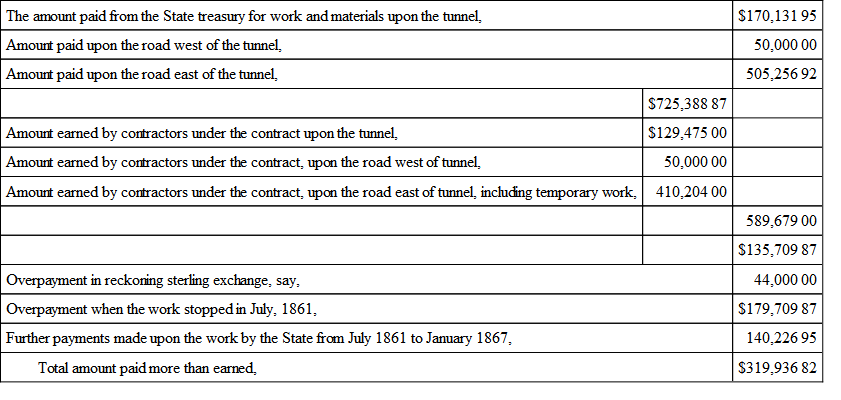
From the foregoing statement it appears that the contractors with the Troy and Greenfield Railroad corporation, have received from the State, three hundred and nineteen thousand nine hundred and thirty-six dollars and eighty-two cents more than the value of the work which the corporation surrendered under the mortgage, and that the State has lost that amount of money in its efforts to assist in the construction of the work. It is proper to add as the judgment of the very intelligent chairman of the commissioners (Mr. J. W. Brooks,) from whose statement to the Committee the foregoing figures are taken, that the loss to the State in the transaction by the failure of Messrs. B. Haupt & Co., to perform their contract in a proper manner, will reach the sum of three hundred and fifty thousand dollars. (See statement, Appendix C.)
The Commonwealth having taken possession of the road and tunnel, and by the legislation of 1862 and 1863 undertaken their construction with the free consent of the corporation, the directors by an appropriate vote, expressed their concurrence with the proceeding, and their reliance upon the "good faith of the legislature" to complete the enterprise which had exhausted the resources of its immediate projectors. The last act of the corporation, as appears by the records, was the choice of officers in August, 1865, when Alvah Crocker was chosen president and Wendell T. Davis, clerk and treasurer.
Description of the Tunnel.
The tunnel enters the eastern side of the Hoosac Mountain, in the town of Florida, a few rods from the right bank of the Deerfield River. The eastern summit of the mountain is 2,210 feet above tide-water, 1,499 feet above the Deerfield River, 1,429 feet above the grade of the railroad, and is distant from the East Portal of the tunnel 6,100 feet. The western summit is 2,510 feet above tide-water 1,788 feet above the Hoosac River, 1,718 feet above the grade of the railroad, and 6,700 feet distant from the West Portal. Each portal of the tunnel is 766 feet above tide-water. The summits are 241/100 miles distant from each other, and the valley between them at its lowest depression is 801 feet above the grade of the railroad.
The length of the tunnel, from the East End to the West End, as commenced by Mr. Haupt, is 484/100 miles. Its base is, at the East End, 70 feet above the Deerfield River, and at the West End, 70 feet above the Hoosac River. Its grade, from the East End to the Central Shaft, is 18 feet per mile; from the West End to West Shaft, 264/10 feet per mile; and from the West Shaft towards the Central Shaft, 2112/100 feet per mile. These grades are calculated to allow the free passage of water from the centre. Should the quantity of water found in the tunnel render feasible a reduction of this grade, a change is contemplated.
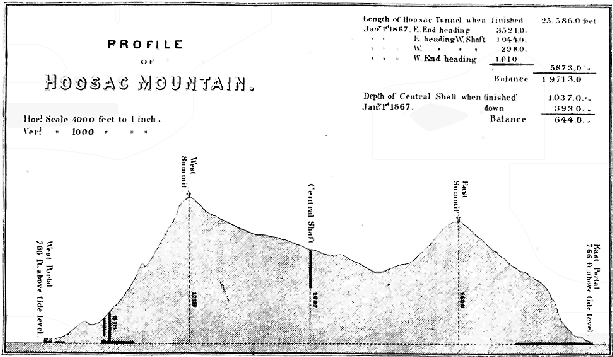
Transcription of text
Profile of Hoosac Mountain
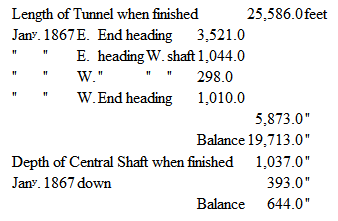
The dimensions of the tunnel areas follows: The rock cutting is 24 feet high and 24 feet wide. The brick-work is 26 feet high and 26 feet wide. The bottom of the tunnel will contain a culvert three feet deep at the centre. Through this culvert the water from the tunnel is to be discharged. It now receives, in addition to the water accumulating in the tunnel, a 12-inch pipe, to carry air at a low pressure for ventilation; an 8-inch pipe to carry air for driving the drilling machines; and a 3-inch pipe for carrying water for use in the holes which are being drilled. Should it be found advisable to use gas in carrying on the work, provision is made for a 4-inch pipe to carry the gas from the place of manufacture. The track is to be placed 31/2 feet above the bottom of the rock tunnel, and 41/2 feet above the bottom, where lined with brick.
The distance by the highway, from the town of North Adams, or from the West End to the East End of the tunnel, is about nine miles. From the first named points to the Central Shaft is about five miles, and from the Central Shaft to the East End the distance is six miles.
The time necessary to travel from the West End to the East End, is two hours. Loaded teams from either end to the other perform the distance and return in a day.
Organization of the forces employed in the construction of the Hoosac Tunnel, June, 1866.
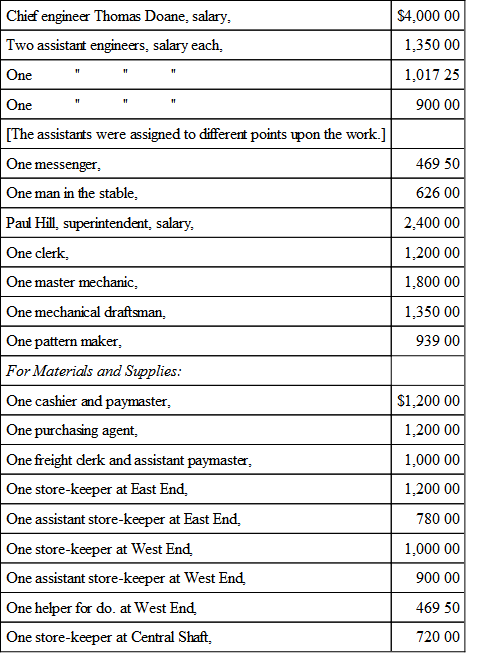
The above were contained on the engineer's pay-roll.
Since the first visit of the Committee to the tunnel, many important changes have been made in the force above mentioned, to wit: The salary of the chief engineer was reduced to $3,600, he to provide his transportation to various points upon the work. One of the assistant engineers resigned and retired, and the office of two of them has been abolished. The salary of the superintendent has been increased to $3,000. The office of freight clerk has been abolished, and its duties transferred to that of paymaster and cashier. The salaries of store-keepers and their assistants were not a charge to the State, but were paid from the profit of their respective stores.
At the commencement of the work, it was deemed necessary to provide stores at the three points where the operations were carried on, to supply the workmen readily with necessaries, so that no time might be lost by them in the important duty of making provision for their families. But in the present state of the enterprise, it is probable that private individuals would readily establish such stores, and relieve the State from a duty which, although it involved no pecuniary charge, diverted to some extent the attention of officers from their more legitimate avocations.
Foremen and Others under the Superintendent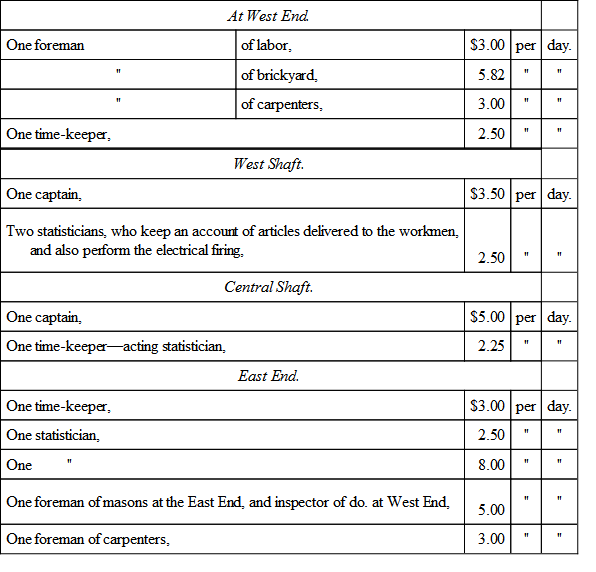
Of this list the foreman of the brickyard is a temporary appointment. The foreman of carpenters at the West End has finished his work and retired. The foreman of masons was discharged by the commissioners, and has entered into the employ of Mr. Farren at the West End.
There are nine foremen of the heading gangs, two of whom have $100 per month, and the remainder $3.00 per day.
The heading gangs consist of eleven drillers each, including the foreman, and from three to five rockmen for removing stone. They work by shifts of eight hours, relieving each other at 8 A. M., 4 P. M., and 12, midnight. The blasts are made about the time of relief. The men working on the enlargement under private contractors make two shifts a day, each shift working ten hours. The Committee made a special examination of the number of men employed under the engineer and superintendent, with a view of considering whether the force actually engaged was necessary to an economical prosecution of the enterprise, intending to suggest any reform that might occur to them as essential; but learning that the engineer would in the course of the year make some reduction in the number of the men as well as of the teams employed upon the work, the Committee deferred taking up the subject until the anticipated reductions should have been made. And now understanding that the commissioners have the whole matter under consideration, and that they have already to some extent, acted thereon, the Committee for reasons that would be obvious, withhold any recommendations or remarks upon this point.
System of Operations.
The general superintendence of the labor on the work is vested in Mr. Hill. The reports are made to the engineer. The captains in the tunnel report weekly the proceedings of each day under the following heads, as follows:—
Number of days' work.
of holes drilled.
of inches of holes drilled.
of drills dulled.
of pounds of powder used.
of feet of fuse used.
of sheets of paper used.
of pounds of soap used.
of pounds of candles used.
of quarts of oil used.
of lamps used.
of pounds of wicking used.
The captain at the shafts four times a month reports,—
The days' work of the engine-men.
The revolutions of the engine.
Number of pounds of coal used.
of feet of wood used.
of gallons of sperm oil used.
of gallons of kerosene oil used.
of pounds of tallow used.
of pounds of waste used.
of pounds of tar used.
of cages raised.
of cars of stone raised.
Size of pump-plunger used.
Length of stroke.
Number of strokes.
of gallons of water raised.
of boilers in use.
The materials furnished for the construction of the work are charged in their distribution to twenty-three accounts, as will be seen by the tabular statement of its cost. Requisitions for materials are signed by the immediate overseer, captain or foreman; they are handed to the superintendent for approval, and by him forwarded to the engineer. If the requisition is approved by both, the materials are ordered, and when furnished the applicant signs upon a duplicate his receipt for the same. This course is pursued as well for materials taken from the State lands as for those purchased. Suitable blanks for returns, requisitions, &c., are furnished to the several points, and the evidence of all the transactions is preserved in the office of the engineer. In addition to the above, a return of all material broken, or laid aside, is made to the engineer, at whose office a substantial account of all materials on hand, either in use, or out of use, may be found.
The organization of the working force, and the mode adopted for supplies and expenditures at the various points, appear well adapted to an efficient and economical prosecution of the enterprise.
Divisions of the Work.
East End
Deerfield Dam.—This structure is completed. Flashboards to be used in low stages of water may have to be occasionally renewed.
The canal is finished as far as wheelpit No. 3. The machine-shop is about 72 feet long, and 36 feet wide. It has three turbine wheels. A fourth wheel is designed, but is not required at the present time, and the pit to receive it is not completed.
In the basement of the machine-shop are two compressors. The first was put in January, 1866. It has four cylinders 13 inches in diameter, and 20 inches stroke. This compressor is used to drive the drills, and furnish air for the blacksmith shop. The second compressor was put in some time in October. It has four cylinders 25 inches in diameter, and 24 inches stroke, and is used for ventilation one-fourth of the time, two hours after each blast, viz., from 8 to 10, A. M., from 4 to 6, P. M., and from 12 to 2, A. M. The compressors work satisfactorily. The loss of power in the transmission of air from the machine-shop to the drills, a distance of 4,500 feet, being hardly perceptible.
In addition to the compressors, there is in the machine-shop the following machinery, viz.: three lathes, one of them worked by hand; a drilling machine; a planer; a bolt-cutting machine and a saw-table. Sixty horse-power is required to carry the machine-drills, the machines in the shop, and to furnish air for the blacksmith shop. When the large compressor is used, 75 additional horse-power is required. A circular saw at the east end of the machine shop, is occasionally used, driven by power derived from the turbine wheels.
The blacksmith shop, near the entrance of the tunnel, contains three forges. The hand-drills are made, and, together with the machine drills, sharpened at this shop. The ordinary repairs of the drilling machines are done in the machine shop. New parts of the same are furnished from Fitchburg.
The heading in the tunnel at this end when driven by hand was about 15 feet wide by 6 feet high. When driven by the machines it is 16 feet wide and 8 feet high. Its location is in the centre of the tunnel, 41/2 feet above subgrade, and 11/2 feet above the road bed.
The force employed at this point in July last was—
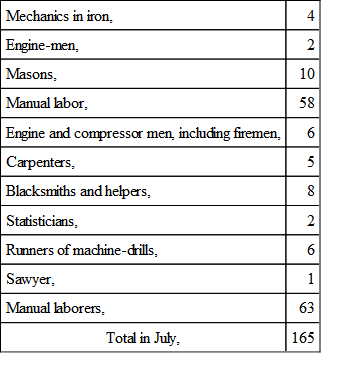
The first day of November there were employed here 115 men. There are at this point, besides the shops and saw mill above mentioned, 2 small offices, 1 boarding-house, 2 carpenters' shops, 2 powder-houses, 1 temporary blacksmith's shop, 1 temporary horse-stable, 3 sheds, 1 engine-house, 1 barn, 1 instrumental station-house (all used by the State,) and 2 cottages; 6 first-class shanties, 13 common shanties, 10 temporary shanties, 1 store under school-room; with 1 cottage, 1 old store and 8 shanties, built by H. Haupt & Company, which are rented.



